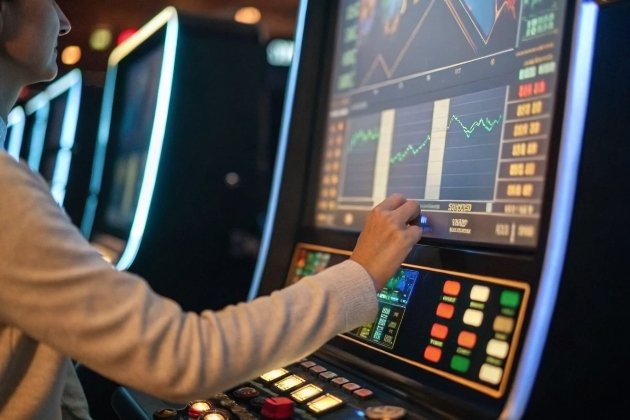I often struggled with games that felt too random, losing money on player wins and losses 1 while trying to keep them happy.
I can adjust the game algorithm’s volatility 2 to control win frequency and size, matching both player enjoyment and my venue’s profit goals. This balance keeps the games exciting while ensuring steady revenue.
To really understand how to tweak volatility, we need to look deeper at the mechanisms behind game algorithms 3 and how it affects player behavior.
Can I Set Specific Win/Loss Cycles in the Game?
I’ve noticed venues lose money when wins appear too often or too rarely, and I wanted a predictable yet exciting cycle.
Yes, I can set win/loss cycles 4 in the game algorithm. This allows the game to produce natural waves of wins and losses, creating both player engagement and profitable patterns for my venue.

When setting win/loss cycles, I first consider player psychology 5. Players want excitement but also hope for wins. I use data and simulations to define hit frequencies that feel natural.
How I Structure Win/Loss Cycles
I use a combination of payout frequency 6, bonus triggers, and symbol distribution. I track past player behavior to see how long they stay engaged. Adjusting cycles isn’t about guaranteeing wins, but creating a predictable rhythm that aligns with venue profit goals.
| Parameter | Low Cycle | High Cycle |
|---|---|---|
| Win Frequency | Every 3-5 spins | Every 8-12 spins |
| Average Payout Size | Small | Large |
| Bonus Feature Trigger | Frequent | Rare |
I also consider the type of venue. Entertainment-focused venues may have cycles with smaller wins more frequently, keeping players engaged. Profit-focused venues favor cycles with fewer wins but higher payouts, increasing net revenue.
Adjustments involve testing different cycles in simulations 7 before applying them live. This allows me to predict player reactions and potential profit. I also monitor sessions in real time and tweak as necessary.
How Do You Ensure the Volatility Matches Player Expectations?
I used to have games that frustrated players—they either won too often or not at all. That caused complaints and reduced visits.
I ensure volatility aligns with player expectations by analyzing session data 8, observing engagement patterns, and adjusting hit frequency, payout size, and bonus triggers for a balanced experience.

Matching Volatility to Players
To match player expectations, I segment my audience. Casual players prefer low volatility with steady small wins, while high-risk players enjoy rare but large jackpots. I use this segmentation to set parameters:
| Player Type | Preferred Volatility | Win Pattern |
|---|---|---|
| Casual | Low | Frequent, small wins |
| Risk-Seeker | High | Rare, large wins |
| Mixed Audience | Medium | Balanced |
I also adjust game elements like reel symbols and bonus frequency. High-value symbols are rarer for high-volatility setups, while low-value symbols appear more often for low-volatility experiences.
I continuously monitor feedback and session analytics. If players feel frustrated or bored, I make incremental adjustments. This ensures games stay fun and profitable.
What Factors Affect the Volatility of the Game Algorithm?
I was confused at first why some games seemed unpredictable despite my careful settings. I realized multiple factors influence volatility beyond basic payouts.
Volatility is influenced by payout frequency, jackpot size, bonus triggers, reel symbol distribution, bet ranges, game speed, and session length 9, all of which can be customized to fit venue goals.

Key Factors
- Payout Frequency: More frequent small wins lower volatility, fewer large wins raise it.
- Jackpot Size: Large jackpots increase volatility due to rarity.
- Bonus Features: Frequent bonuses lower volatility, rare high-stakes bonuses raise it.
- Reel Symbol Distribution: High-value symbols increase volatility; low-value symbols decrease it.
- Bet Range: High maximum bets increase volatility, low bet caps reduce it.
- Game Speed: Faster games create more streaks, increasing volatility; slower games smooth it.
I often use Monte Carlo simulations 10 to test how these factors interact. This lets me predict outcomes before releasing the game. I also track real-time data, which helps dynamically adjust parameters for changing player behavior.
Can I Get Reports on the Game’s Volatility Over Time?
I needed evidence that my adjustments actually improved profit and player satisfaction, not just assumptions.
Yes, I generate detailed reports on game volatility, including win/loss frequency, average payouts, bonus triggers, and session patterns. These reports help optimize game algorithms for consistent profitability.

Reporting and Analysis
Reports track all relevant metrics and allow comparison between different cycles or game versions. I use these insights to adjust RTP and volatility dynamically.
| Metric | Description | Frequency |
|---|---|---|
| Hit Frequency | Number of wins per session | Daily |
| Payout Size | Average payout per win | Daily |
| Bonus Trigger Rate | Bonus activation frequency | Weekly |
| Session Engagement | Avg playtime per session | Weekly |
Regular analysis ensures my games stay fresh and appealing, preventing boredom and keeping venues profitable. It also helps identify patterns in different player types, allowing me to customize games further.
Conclusion
Adjusting game volatility with data, player insight, and careful testing ensures my games remain fun, fair, and profitable while meeting venue goals.
Footnotes
1. Guide to understanding player wins and losses in gaming. ↩︎
2. Definition and importance of slot volatility. ↩︎
3. Overview of game algorithm mechanisms for developers. ↩︎
4. Explanation of win/loss cycles in casino games. ↩︎
5. Psychology principles behind player engagement. ↩︎
6. Understanding payout frequency in game design. ↩︎
7. Simulation tools for testing game cycles. ↩︎
8. How session data informs volatility adjustments. ↩︎
9. Factors influencing game algorithm volatility. ↩︎
10. Using Monte Carlo simulations to predict game outcomes. ↩︎



